
|

|

|
|
|
An up close and personal interview with U.S. Navy Veteran and Togetherweserved.com Member:
RM3 Frederick Boutcher U.S. Navy (1966-1970)
PLEASE DESCRIBE WHO OR WHAT INFLUENCED YOUR DECISION TO JOIN THE NAVY?
 |
| Evert sence I was 8 years old I knew I wanted to go into the Navy |
 When I was 8 years old, (1956) my mother's cousin, Jimmy Mockler came to the house to visit. Jimmy was on leave from the Navy, he was a Third Class Photographers Mate stationed on the USS Forestall. He had with him pictures of the aircraft carrier he had taken from a helicopter and I was totally captivated. Then over dinner he told us all about how the carrier docked all over the Mediterranean and showed pictures of all the sights he had seen while on liberty. I was hooked! This is exactly what I wanted to do when I grew up and the desire never changed for the next 10 years. I wanted to go into the Navy, get on a great ship and sail around the world like cousin Jimmy. When I was 8 years old, (1956) my mother's cousin, Jimmy Mockler came to the house to visit. Jimmy was on leave from the Navy, he was a Third Class Photographers Mate stationed on the USS Forestall. He had with him pictures of the aircraft carrier he had taken from a helicopter and I was totally captivated. Then over dinner he told us all about how the carrier docked all over the Mediterranean and showed pictures of all the sights he had seen while on liberty. I was hooked! This is exactly what I wanted to do when I grew up and the desire never changed for the next 10 years. I wanted to go into the Navy, get on a great ship and sail around the world like cousin Jimmy.
WHETHER YOU WERE IN THE SERVICE FOR SEVERAL YEARS OR AS A CAREER, PLEASE DESCRIBE THE DIRECTION OR PATH YOU TOOK. WHAT WAS YOUR REASON FOR LEAVING?
US NAVAL ASSIGNED DUTY STATIONS 1966 TO 1970
May 2nd 1966 - Sworn into the US Navy Reserves in part of the Cache Program a three month delay for reporting for active duty. Allowed me to graduate from High School and avoid the possibility of being drafted.
August 10th, 1966 Reported
 |
| Entered Boot Czmp at Great Lakes Aug. 10th 1966 |
to US Navy Recruiting Representative Armed Forces Entrance Station, White Street, Building #116, Fort Hamilton, Brooklyn to be sworn into the regular Navy for active duty and transportation to US Naval Training Center Great Lakes, Illinois to begin 12 weeks of Naval Boot Camp.
November 2nd, 1966 - Ordered to Basic Electricity and Electronics School at NTC Great Lakes Illinois for 12 weeks of very intense training regarding Electricity and Electronics.
January 26th, 1967 - Ordered to Radioman A School at Naval Training Center, Bainbridge, Maryland for 12 weeks of very intense training in communications including operating and repair of communication equipment, Morse code and teletype equipment. Also ordered to complete the Military Requirements for PO 3&2 NAVPERS 91206-E. Made rate, RM3 (E4) on March 10th, 1967.
April 8th, 1967 I got my orders to proceed from Radioman A school, Bainbridge, Maryland to Comseventhflt Staff Det. A, Formosa Fordu (sea).On the orders it states:
2. EFF TRF PROV HIGH CAL INDIV AND QUAL SERV ON FLT STAFF. INCL FOL STATEMENT FACE STA TRAFO CONSIDERED QUAL AND RECMD FOR FLT STAFF DUTY BASED ON PERSONAL INTERVIEW AND CLEAR RECORD SIGNED BY PERS OFF. ADVISE EDOPAC BY MSG WITHIN 5 DAYS OF RECEIPT MBR NO CONS QUAL ADCON. 3. MUST HAVE TOP SECRET CLEARANCE DOCUMENTED IN SERVREC PRIOR TRF.
Wow, I thought that I was getting into something really special. COMSEVENTHFLT Staff Det Alpha! And the orders state that I was a high caliber individual. I arrived and the second day I was there, I was pushed into a Pathfinding course run by the US Marines and the Taiwanese Marines on Grass Mountain which was sort of in the middle of the Taiwan Island. This course went on for four weeks non-stop and then I was pushed into a crash, one week,  Jump Course run by the Taiwanese Air Force; I have Taiwanese Jump Wings! Finished the two courses, I was allowed to relax for about two weeks while I attended classes on voice radio communications and naval gun fire corrections and was told that I was being trained for the duty of a Forward Observer (FO) and was going to be TDY to COMSEVENTHFLT Naval and Air coordinate Elementor Element, Danang operating with the 1st Marine Unit based at Monkey Mountain. I was issued jungle greens and boots. Jump Course run by the Taiwanese Air Force; I have Taiwanese Jump Wings! Finished the two courses, I was allowed to relax for about two weeks while I attended classes on voice radio communications and naval gun fire corrections and was told that I was being trained for the duty of a Forward Observer (FO) and was going to be TDY to COMSEVENTHFLT Naval and Air coordinate Elementor Element, Danang operating with the 1st Marine Unit based at Monkey Mountain. I was issued jungle greens and boots.
May 29th 1967 I was transferred from COMSEVENTHFLT Staff, Det A on Taipei, Taiwan to SEVENTHFLT Naval and Air Coordinator Element Danang and upon my arrival, handed over to the 1st Marines, Monkey Mountain who immediately took me out on six man night patrols with the specific purpose of making contact and having my cherry busted; my baptism by fire, so to speak. The third night out we made contact, I performed to their standard and I was accepted. From June 1st 1967 till December 10th 1967, I humped the jungles with the 1st Marines, spotted Air strikes, corrected observed naval gun fire on specific targets and sat on listening posts. The six man teams humped into the bush from the base of Monkey Mountain. We were also Heloed into the bush and dropped off for four to five days at a time, and did 8 jumps into AOs (Area of Operations) and were then extracted by Helo. Each time I was in the bush with five Marines,  me making the team of six. Got into some heavy fire fights, saw friends I had made with the Marines killed and did my share of killing. Usually we would go out for four or five days and then stand down for four or five days as another FO unit would go out. I spilled my blood in the jungles of Nam but my blood came out of scratches I got from some incredible thorns and was withdrew by leaches and mosquitoes and huge black flies. But I never got hit with a piece of shrapnel or a bullet. The Marines I was with said that I was bullet proof. me making the team of six. Got into some heavy fire fights, saw friends I had made with the Marines killed and did my share of killing. Usually we would go out for four or five days and then stand down for four or five days as another FO unit would go out. I spilled my blood in the jungles of Nam but my blood came out of scratches I got from some incredible thorns and was withdrew by leaches and mosquitoes and huge black flies. But I never got hit with a piece of shrapnel or a bullet. The Marines I was with said that I was bullet proof.
Dec 15th 1967 I was ordered back to COMSEVENTHFLT Staff Det A at Taipei, Taiwan. Felt really good to be out of Vietnam Bush, was like being on R&R. Attended another Jump Course with the Taiwanese Air Force and a refresher course in Pathfinding with the US and Taiwanese Marines and was used as a Show and Tell subject talking about my actual time in the Nam bush to newbies.
Feb 10th, 1968 I was ordered to Osan, Korea to work with the Naval Section TACC (Tactical Air Coordination Center) in regard to the North Korean attack and capture of the USS Pueblo on January 23rd, 1968. Stayed there for three months in the coldest weather I have ever had to deal with in my entire life. Brrrrrrr! Man if you peed you had to snap the frozen stream of pee off your ding a ling! Was with the TACC for three months and then ordered back to COMSEVENTHFLT Staff Det A on April 30th, 1968. Felt good to be in Taipei once again. But it was not for long.
May 17th, 1968 - I was ordered back to SEVENTHFLT Naval and Air Coordinator and reassigned to the 1st Marines at Monkey Mountain and was back in the bush. But this time I was in the bush as an observer of new FOs. Something I never had. The Marines were very happy to see me back.
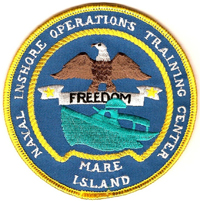 July 29th, 1968 - I was ordered back to COMSEVENTHFLT Staff Det A on Taiwan to be given my orders to Mare Island Naval Inshore Training Facility in Vallejo, California to learn how to operate an Alpha Boat. I was being assigned to as part of the MRF (Mobile Riverine Force). I was going back to Vietnam into combat running on the rivers of the Mekong Delta; operated with the MRF for 18 months. July 29th, 1968 - I was ordered back to COMSEVENTHFLT Staff Det A on Taiwan to be given my orders to Mare Island Naval Inshore Training Facility in Vallejo, California to learn how to operate an Alpha Boat. I was being assigned to as part of the MRF (Mobile Riverine Force). I was going back to Vietnam into combat running on the rivers of the Mekong Delta; operated with the MRF for 18 months.
December 4th, 1969 Ordered to the USS Chevalier, DD 805 out of San Diego. For a period of three years and eight months I have been part of six man teams, operating in the jungles of Vietnam around the DMZ and then on an Alpha Boat operating on the Rivers of Vietnam's Mekong Delta. I was at constant state of combat readiness, killing, seeing friends killed and wounded, living in mud and on a 50 foot patrol boat; to be ordered to a Ship with more than 400 sailors in its crew, who have never had a shot fired at them in anger. I found myself in an atmosphere of jealousy and being ostracized by both Enlisted and Officers including the Captain because of the medals, citations and ribbons, all combat orientated, I had on my ribbon rack. Not the Navy I dreamed of as an 8 year old boy!
May 1st, 1970 Based upon my Vietnam Service and the nastiness I found on the USS Chevalier DD 805, though offered E-5 and a $10,000 ship over bonus, I opted for a 3 month early out. End of my Naval Career.
IF YOU PARTICIPATED IN ANY MILITARY OPERATIONS, INCLUDING COMBAT, HUMANITARIAN AND PEACEKEEPING OPERATIONS, PLEASE DESCRIBE THOSE WHICH WERE THE MOST SIGNIFICANT TO YOU AND, IF LIFE-CHANGING, IN WHAT WAY.
Fire fight: Recall all the things that have happened in your life that have scared you a little bit or a lot, roll all those instances of fright together and think about how you felt at each individual moment of being scared. Now, imagine if all those frightening feelings of each moment were to jump into you at one time.
When you are training to become a part of a very small military team of men who are going to go out into an extremely hostile environment basically looking for trouble, the training is a whole lot more than those who have never been involved in such a thing. Sure there is the living off the land and the ability to move with stealth, how to maintain your weapons so you know they will function whenever you need them to.  Then there is the jump training and how to repel out of a helicopter or down the face of a cliff. You learn how to ignore pain, how to perform serious first aid in the field; under the most adverse conditions. How to keep your head clear and straight when in situations that are totally and completely uncontrollable and out of hand. You learn how to ignore the screams of those near you when they get hit and how to step past your friend just after he died and keep in total control so as to be able to kill your enemy; when everything about what is going on at the time is unrealistically clogged with sounds of death, gun fire, explosions, screams, the smell of fresh tilled dirt mixed with the scent of spent gun powder, the disgusting stench of the ripped open bowls of a human body and at the same time know how to get on a radio, in the middle of all this, and calmly call for a fire mission giving map coordinates of the enemy (not yours). Then there is the jump training and how to repel out of a helicopter or down the face of a cliff. You learn how to ignore pain, how to perform serious first aid in the field; under the most adverse conditions. How to keep your head clear and straight when in situations that are totally and completely uncontrollable and out of hand. You learn how to ignore the screams of those near you when they get hit and how to step past your friend just after he died and keep in total control so as to be able to kill your enemy; when everything about what is going on at the time is unrealistically clogged with sounds of death, gun fire, explosions, screams, the smell of fresh tilled dirt mixed with the scent of spent gun powder, the disgusting stench of the ripped open bowls of a human body and at the same time know how to get on a radio, in the middle of all this, and calmly call for a fire mission giving map coordinates of the enemy (not yours).
Seems like a whole lot to learn. But there are still things that you are not going to take with you, but must, absolutely, understood. These things are the physics of your assets; assets? These are the things that you might call upon to help you out of a very tight situation. Assets like, Artillery, Mortar fire and Jets. You must also know and understand the physics of the armament you are going to be calling for. Artillery shells, how far can they go, what is the blast area, how much concussion do they produce. Are they high explosive, fragmentary or incendiary. Same goes for mortar rounds. But jets, well that brings in the physics of mass and speed and angles of trajectory. You have to know how fast the jet is travelling, how high it is (altitude) and what kind of armament it is carrying. You must also know the physics of the armament as to type, blast field and concussion; as well as know how to call in a Jet, how to guide the jet to the proper coordinates in day and night. All this information makes your assets friendly to you and deadly to your enemy.
This was to be a snatch ambush. US MACV (Military Assistance Command Vietnam) Intelligence had determined there was a constant stream of information, being carried by way of courier, both from South Vietnam to the North and from North Vietnam to the South. Two times a month this courier would be carrying information. The earlier part of the month would be information from the North to the South. This was information the Military Intelligence Community would like very much to have. Not only would they like to have the information, but they would also like, very much, to talk with the courier himself. 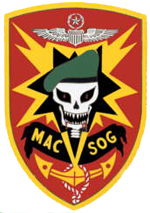 It was felt that he could put forth some very lucrative information that would be highly beneficial to the US Military Operations within South Vietnam. It was felt that he could put forth some very lucrative information that would be highly beneficial to the US Military Operations within South Vietnam.
The Song Ngan River Valley, some 10 kilometers northwest of Cam Lo, just below the DMZ was the route that was used by the courier to go and come. Intelligence stated that the courier was always escorted by a Squad of about 10 NVA (North Vietnamese Army) Soldiers bearing standard infantry weapons. AK47s, small arms and RPGs (Rocket Propelled Grenades).
A small Team of six was put together and a quick rundown briefing was presented and a standard ambush snatch operation planned. The six were Matthew B., James T., Bobby S., Terry M., Jimmy S. and me. We would be carrying with us two M60 machine guns, four Cadillac Stoners, six Colt 45 semiautomatic pistols, twenty four Mark I fragmentary hand grenades, two PRC 25 radios and six spare batteries, two first aid pouches and various different types of knives. Each of the six man team would carry the following. . .
Matthew B. M60, 45 with five clips, knife, 4 Mark I hand Grenades, two batteries for the PRC 25 Radios.
James T. Cadillac Stoner with five 110 round box clips, 45 with five clips, knife 4 Mark I hand grenades, two batteries for the PRC 25 Radio and first aid pouch.
Bobby S. - Cadillac Stoner with five 110 round box clips, 45 with five clips, knife, 4 Mark I hand grenades, two batteries for the PRC 25 Radio and a PRC 25 Radio.
Terry M. M60, 45 with five clips, knife, 4 Mark I hand grenades, two batteries for the PRC 25 Radio.
Jimmy S. - Cadillac Stoner with five 110 round box clips, 45 with five clips, knife, 4 Mark I hand grenades, two batteries for the PRC 25 Radio and first aid pouch.
Me - Cadillac Stoner with five 110 round box clips, 45 with five clips, knife, 4 Mark I hand grenades, two batteries for the PRC 25 Radio and a PRC 25 Radio.
In addition to all we were already carrying, we each also carried four belts of 100 rounds of 7.62 mm for the two M60 Machine guns. This gave 2,400 rounds for the two M60s.
The two of us who were carrying the PRC 25 Radios, Bobby and me, also carried a  Brunton Navigational Compass, a stop watch and topographical maps of our AO (Area of Operation) and a special flash light that put out an inferred light beacon. We also had to memorize the call signs of the assets that we could call upon if needed. Brunton Navigational Compass, a stop watch and topographical maps of our AO (Area of Operation) and a special flash light that put out an inferred light beacon. We also had to memorize the call signs of the assets that we could call upon if needed.
In addition to all the weapons and ammunition, each of us also carried two, one quart canteens of water and six LRP (Long Range Patrol) food packs. (Dehydrated food in a pack. Add some water, wait a few minutes and you had a meal.) The LRP was referred to as, Gravy Train.
The operation. The team was going to be choppered in and dropped about six clicks from the Song Ngan River Valley. We were to make our way to the area so designated on the topographic maps and set up our ambush. We would stay on station for four days. During these four days it was expected that the currier and his escorts would pass through the area. There was a pick up point, about one kilo meter from the point of our ambush, where we would rendezvous. If after four days the courier did not show, we were to withdraw. A simple, piece of cake snatch operation; in and out!
Ambush was set, the two M60s on the two ends of our ambush line and the rest of us spread about six feet from each other. We were set as, north to south, Matthew M60, James, me, Jimmy, Bobby (all with Stoners) and Terry M60. The M60s would fire on full auto while the four Stoners would fire on Stitch (The Stoner could be fired on single, one round at a time, full auto and stitch which fired three rounds each time the trigger was pulled).
Into the late afternoon of the second day on station, the point man for the courier and his escorts came through the area. You do not take out the point man, you let him go through because the point man is usually about 50 meters in front of the unit, checking the way. So you let him go by but you send someone after him so when the ambush it initiated, he is taken out so as not to come back with a flanking fire. James was the one to go after the point man.
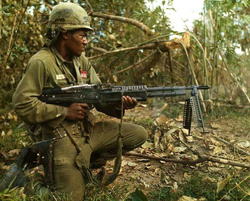 James backed out of position and shadowed the point man and as expected, about 50 meters behind (about three minutes after the point man passed) The courier and his escorts, ten of them, stepped into the kill zone of our ambush and the two M60s initiated the ambush with the three Stoners following. It was over as quick as it started. The courier was down, not hit, just down but all the escorts were dead. James backed out of position and shadowed the point man and as expected, about 50 meters behind (about three minutes after the point man passed) The courier and his escorts, ten of them, stepped into the kill zone of our ambush and the two M60s initiated the ambush with the three Stoners following. It was over as quick as it started. The courier was down, not hit, just down but all the escorts were dead.
Jimmy was the one to break cover and snag the courier; James would return to the ambush site and assist Jimmy. The rest of us remained on station to give cover. It was over, just like that, it was over and we had in our possession the courier and all the documents he was carrying from his headquarters, in the North, to where ever it was he was going to in the South.
MACV Intel was dead on and this operation was indeed a piece of cake. But than nothing in Nam was ever really a piece of cake.
While MACV Intelligence knew all about the movements of the courier and the approximate times that he would be in the area, seems they knew nothing, nothing at all, about the company of NVA that were following, about one kilometer, behind the courier; we did not know about them neither!
Matthew, who was in charge of our team told me to get on the Radio and tell our net control that we had the package in hand and pick up was to be made at the arranged rendezvous point. Our package was gagged with tape over his mouth and hands cuffed behind his back. Jimmy and James had custody as we broke from the ambush site and headed for the chopper pick up point. I took point and lead the Team. All was perfect, it was dark, about 8:30 PM. The PRC 25 Radio I was carrying hissed three times. This was the signal from the chopper pilot for me to contact him. I made contact and he asked for our Inferred light beacon to be used so as to pin point our location in the dark. The chopper pilot would be wearing goggles that would allow him to see our inferred light beacon. Without such goggles the inferred light beacon could not be seen.
The Chopper began its decent into the open field, the pilot would bring the craft to about a foot off the ground so as to maintain lift. We would then make a running dash to get on board and it would be home free. At about 50 feet from the ground, the Chopper started taking Heavy machine Gun fire from both sides, green tracers belched out of the jungle and ripped the Chopper to pieces. It fell from the sky and upon hitting the ground blew into a greasy yellowish orange ball of flame.
Under the brightness of the fiery death of the chopper and its crew, all hell broke loose around our Team. We took position in a depression and began to lay down suppression fire. Jimmy took his knife and cut the hamstrings on both legs of the NVA Currier so he could not try to escape.
The big problem was that the flash of our fire pin pointed our position and the NVA 51s (heavy 51 Cal Machine Guns) began to mow the ground towards us. Bobby and I both got on our PRC 25s and started contacting two separate artillery battery emplacements that would be within our range; their range being 7 miles. 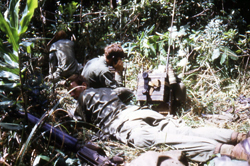 Contact was made but during the process of giving the firing coordinates, Bobby's PRC 25 took a hit and we now had only the one Radio I was talking on. Gave the coordinates and asked for corrective fire. This is one round that is fired and after it hits you can say if it is on target or if it needs to be adjusted in a bit more or less range or to the right or to the left. Once you got the corrective fire you could call, Fire for effect. Contact was made but during the process of giving the firing coordinates, Bobby's PRC 25 took a hit and we now had only the one Radio I was talking on. Gave the coordinates and asked for corrective fire. This is one round that is fired and after it hits you can say if it is on target or if it needs to be adjusted in a bit more or less range or to the right or to the left. Once you got the corrective fire you could call, Fire for effect.
Our M60s were metering out what we had but with controlled fire. You hold the trigger of a M60 and you have a fire rate of 600 rounds per minute at 2,800 feet per second. But when you only have 1,200 rounds for each M60, shit if you hold the trigger you will go through 1,200 rounds in two minutes! We were going to be here for longer than that so controlling the rate of fire was of extreme importance. From the green tracers flying at us with the sickening sound of a hissing buzz flying past and slamming into the ground all around us we could make them our main target. Them alone were more than enough to chews us up. We also had to try our very best to keep the enemy from flanking us. I did this by having the 105 Howitzer artillery, that was firing for us, to sort of roll back and forth from three sets of coordinates I had worked out as the location of the enemy. This artillery battery had six howitzers, each Howitzer could put out fire at the rate of about ten rounds per minute. But when you are humping a thirty three pound shell, the rate of fire could easily drop to about 7 rounds per minute. Not a whole lot, forty two 105 mm rounds exploding every minute creating a sort of metal curtain between the NVA and the six of us. (It may sound like a whole lot of shit going off, forty two 105 mm rounds exploding every minute, but when you consider the rate of fire the NVA had beading in on us, two 51 cals with a fire rate of six hundred and forty rounds per minute meaning 1,280 rounds of 51 Cal coming at you in addition to the four RPK light machine guns with a firing rate of six hundred rounds per minute of 7.62 mm, that is 2,400 rounds of 7.62 light machine gun fire coming at you and the un told number of AK-47s that were being fired at you with a firing rate of six hundred rounds per minute, because of a 30 round clip and need for reloading lets say that out of the one hundred and fifty NVA with AK-47s, 50 were constantly being fired at you so that is another 1,500 rounds of 7.62 rounds flying towards you. Add all that together and you find an incredible number of 5,180 pieces of metal death flying through the air all around you. So again, forty two 105 mm shells going off every minute does not sound like a whole lot!
Our own fire power was very limited as there were only six of us. The two M60s and four Stoners put out a total of about 3,600 rounds a minute. But we were trained in controlled fire and controlled fields of fire. The NVA, not to take anything away from them, they simply pointed in a general direction, pulled the trigger and hoped for the best. That was one of the things that we had in our favour; intense training in fire control and targeting. But we were in big shit. We were going to be out of ammunition pretty soon and that would bring it down to 24 hand grenades, six knives and six 45s. Basically hand to hand fighting with six against 200! We were going to need some big boy help and we were going to need it really quick. Matthew and the others were sort of hunched around me now as I was the only one with a Radio and if we were going to get out of this, this PRC 25 Radio was the very thing that was going to make that happen.
About an hour and a half had passed in what seemed to be a single heartbeat. Miraculously not one of us had been hit yet. Everyone had scratches and some shrapnel sure, but a direct hit, no. How long was this going to be able to continue? The Artillery Battery called me and said that they were about out of 105s and I was going to have to contact another artillery battery. I switched frequencies to the frequency Bobby had had the other artillery battery on and explained our situation and what we needed from them. Battery A stopped firing and Battery B picked it up so our curtain was still falling between us. But it was not going to save us. We needed something really big, something that would take the starch right out of the NVA and end this hell.
 Switched to our main frequency and called our operation control telling them we needed some Jets to pull our ass out of this hell hole we were in. I was told that a flight of four, F4 Phantoms could be on our coordinates in about 20 minutes. Asked what kind of armament I desired, damn it was like being at the ice cream parlor and the soda jerk was asking me if I wanted sprinkles on my ice cream cone! Told control that I wanted two with napalm and two with 500 pound HE (High Explosive) bombs. Gave my coordinates and made my plans. Switched to our main frequency and called our operation control telling them we needed some Jets to pull our ass out of this hell hole we were in. I was told that a flight of four, F4 Phantoms could be on our coordinates in about 20 minutes. Asked what kind of armament I desired, damn it was like being at the ice cream parlor and the soda jerk was asking me if I wanted sprinkles on my ice cream cone! Told control that I wanted two with napalm and two with 500 pound HE (High Explosive) bombs. Gave my coordinates and made my plans.
At this point we were just about out of ammunition and we were starting to worry. But I had a plan that I felt would get us right out of this shit. Told the guys that we had to hold for 20 minutes. Had to hold tight and make every round that we had have a purpose! Aim it and single fire on each target. One shot one kill. Told them that we had jets coming in but that posed a major problem, for the jets to come in the artillery would have to be lifted. Lift the artillery and we will have no coverage. But, if it were timed properly it would leave a window of no coverage of about 20 seconds. While the Team took their selective shots I explained how this was going to work. The biggest problem was the jets knowing exactly where we are. Problem with that, was that it was the middle of the night, there was no way a smoke grenade was going to be able to mark us and our inferred light beacon was not going to be able to penetrate through all this smoke. But there is still another way.
Back in training when we were learning about Jets and their armament, we also learned about a bombing method that took a huge about of guts, balls, mathematical calculations, excellent navigational ability and someone crazy enough to try it. This method is called, Doppler Bombing. It is based upon the understanding of the Doppler effect. The Doppler effect is the changing of a sound as it travels towards you and as it travels away from you. Think of a racing car coming down the track towards you, speeds past you and goes away. The sound is like. .rrrrrrrrrrrrrrrrrrrrrRAHoooooooooooooooooooo.
The loudest of all the sound herd is when the object making the sound is directly in front of you or in this case with the jets, directly over you. Next you have to know the trajectory of the armament, in this case the napalm and 500 pound bombs. The altitude of the jets and their speed had to be spot on. So if you know how fast the Jet is going and the altitude of the Jet as it passes and the weight of the object that is going to be dropped you can calculate the time it would take for the object to hit the ground. Need to know where the enemy is in relationship to where we are. In the dark that can be a bit difficult. But we are all professionals and between the six of us taking a guess at it can pretty much come up with an average distance between our team and the enemy.
 The jets were on their way and would be on our location in about six minutes. I told the pilot what heading I wanted him to come in on our coordinates, what speed I wanted him to be going and what altitude. Said that I wanted the napalm to come first, all four canisters and five seconds behind the napalm I wanted the 500 pound bombs, two of them. The pilot asked me if I was going to make this a doppler raid? I told him yes and that it was going to be dangerously close to us so he was going to have to be spot on to my instructions and drop exactly when I said drop. The jets were on their way and would be on our location in about six minutes. I told the pilot what heading I wanted him to come in on our coordinates, what speed I wanted him to be going and what altitude. Said that I wanted the napalm to come first, all four canisters and five seconds behind the napalm I wanted the 500 pound bombs, two of them. The pilot asked me if I was going to make this a doppler raid? I told him yes and that it was going to be dangerously close to us so he was going to have to be spot on to my instructions and drop exactly when I said drop.
Of course the team thought that it was true, I really was fuckin' crazy! I hoped that I really knew how to do what I was about to do. Told them that the first run with the Napalm was going to be right at the edge of the 200 meters we all guessed the distance to the enemy to be. That would create a huge wall of fire that burns at 1,500 F and will burn for about 25 to 30 seconds. The following jet coming in five seconds later will drop two 500 pound bombs and their concussion will blow the wall of 1,500 F flames right into the NVA faces! If the first run does not break the NVAs spirit we haves a second run that can be made as we have four jets. But I said to the Team, We are going to get singed with this.
Gave the first jet the heading to our coordinates, he came back and repeated the heading to me. Told me he was 30 seconds out. I told him he was to drop when I said drop. Called the artillery and told them to hold fire. Listening very hard for the sound of the jet approached our position, I had the stop watch in my hand. Had calculated that he needed to drop 2 seconds after he flew directly over us. The sound grew louder and louder and at the moment my ears heard the sound change its pitch and tone I hit the stop watch and watched the second hand count one, two I said into the radio, Drop!
Just pasted where the helicopter had been shot down, the world bust into a brilliant orange yellow wall of fire that was putting out heat like a blast furnace. Five seconds later the second Jet was coming in on the heading. Again my ears had to listen for that change in pitch and tone. There is was and one and a half seconds later I said, Drop! We all hit the dirt and exhaled, holding the breath out of our lungs so the concussion would not break our ribs and then there were two blasts that rocked the earth. The concussion blew over us and in the opposite direction at the wall of fire which was blown into the faces of the NVA. Fire from the NVA stopped abruptly. Not wanting to have the other two jets miss out on the roast, told them to put their stuff on top of what they saw. So they both made their runs and dropped their napalm and 500 pound bombs on top of the burning NVA position. The jets were gone, the NVA shooting was gone, the position that was theirs was now a flaming inferno. The team started yelling and screaming about this very crazy asshole Radioman who just pulled all the stops out and lifted the team right out of Hell. I looked to Bobby and with a hand that was uncontrollably shaking and a voice that did not want to work told him to get us the fuck out of here. Bobby took the radio, I stated shaking all over and tears ran down my face with steams that cleared off the dirt leaving white trails running down my face. I was totally spent. When the Chopper arrived with a two gun ship escort we piled our package and ourselves in.
The time from when the recovery chopper was shot down, killing the entire crew, till the time I told the second jet to drop was just about one and a half hours. At this moment having finished writing, I am totally covered with sweat, the hair on the back of my head is standing on end, I am shaking and I have tears in my eyes.
OF ALL YOUR DUTY STATIONS OR ASSIGNMENTS, WHICH ONE DO YOU HAVE FONDEST MEMORIES OF AND WHY? WHICH ONE WAS YOUR LEAST FAVORITE?
Through out my time in the US Navy, 1966 to 1970 I had four duty stations. The first being the two schools I was sent to, the second was operating as an FO with the 1st marines out of Monkey Mountain Vietnam, the third was as Radioman Coxswain on board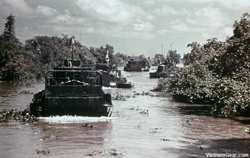 the Alpha Boat A-91-3 and the fourth the Destroyer USS Chevalier DD 805. the Alpha Boat A-91-3 and the fourth the Destroyer USS Chevalier DD 805.
My fondest memories come from the small units I was part of when operating as an FO, during my first tour in Nam and Radioman/Coxswain on board A-91-3 during my second tour in Nam.
Being small units we each came to depend upon each other for our very lives. The camaraderie between us all was very tight, total trust and friendship. Every time we went out we all knew that to come back we all had to work as a single unit. Each of us knew how the other would react and we never questioned each others motives.
The USS Chevalier DD 805, now this was nothing at all what I had been involved with during the past three and a half years. This was a ship with a crew of 400+ and they all were not very happy about me. The unhappiness came from the two quarters the Captain had to hold to present to me citations, medals and ribbons that followed me from Nam and had nothing to do with the USS Chevalier DD 805. The five months I spent on the Chevalier were the worst five months on my short Naval career.
WHICH INDIVIDUAL(S) FROM YOUR TIME IN THE MILITARY STAND OUT AS HAVING THE MOST POSITIVE IMPACT ON YOU AND WHY?
 There are two groups of individuals who stand out from my time in the US Navy. There are two groups of individuals who stand out from my time in the US Navy.
First group . . .
Jimmy Scantlin
Terry MacKeef
Bobby Shepard
When I was out in the bush as an FO these three were there to CMA (Cover my ass) at all cost.
Second Group. . . .
Jeff Chandler
Duke Hamilton
Roger Hillard
Jerry Rod
Willy Brown
These five plus myself made up the crew of A-91-3. We lived it together, we fought it together and we constantly had each other back. Keep in your mind that many of the rivers and canals we took A-91-3 into were so small that when we got into a fire fight it was at point blank range.
PLEASE RECOUNT THE NAMES OF FRIENDS YOU SERVED WITH, AT WHICH LOCATION, AND WHAT YOU REMEMBER MOST ABOUT THEM. INDICATE THOSE YOU ARE ALREADY IN TOUCH WITH AND THOSE YOU WOULD LIKE TO MAKE CONTACT WITH.
From my first tour I remember Jimmy Scant,in, Terry MacKeef, and Bobby Shepard. We humped the jungles around Monkey Mountain and Marble Mountain up around the DMZ and we simply took care of each other.
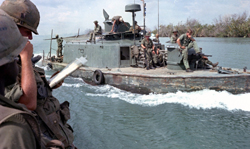 From my second tour, Jeff Chandler, Duke Hamilton, Roger Hillard, Gerry Rod and Willy Brown. We were the crew of A-91-3. A fifty foot boat sounds big till you have to live on board with five other guys. But when we got into point blank fire fights we all knew that each of us had each others lives in our hands. Me in the handling of the boat and communications skills. Jeff for his ability to direct fire, Willy for his expertise with the 20mm rapid fire cannon, Roger for his expertise with the twin 50's, Duke for his expertise in maintaining the two 12V71 engines and Jerry for his expertise with the 30 cal machine guns and the Honeywell 40mm grenade launcher. From my second tour, Jeff Chandler, Duke Hamilton, Roger Hillard, Gerry Rod and Willy Brown. We were the crew of A-91-3. A fifty foot boat sounds big till you have to live on board with five other guys. But when we got into point blank fire fights we all knew that each of us had each others lives in our hands. Me in the handling of the boat and communications skills. Jeff for his ability to direct fire, Willy for his expertise with the 20mm rapid fire cannon, Roger for his expertise with the twin 50's, Duke for his expertise in maintaining the two 12V71 engines and Jerry for his expertise with the 30 cal machine guns and the Honeywell 40mm grenade launcher.
Have never seen or heard from any of them, first tour or second tour, since our time together in Nam.
CAN YOU RECOUNT A PARTICULAR INCIDENT FROM YOUR SERVICE WHICH MAY OR MAY NOT HAVE BEEN FUNNY AT THE TIME, BUT STILL MAKES YOU LAUGH?
Any one particular incident? No not really. But I do know that the time I spent in Nam, my first tour and second, was filled with either horrifically terrorizing moments or hysterical laughing moments. Did not seem to be a time when we were not enjoying and laughing with each other when not in deadly combat.
B ut! There is a time in Dong Tam (That was a major MRF base south of Saigon) at the NCO Club. There was a game that was played. I never, absolutely never ever saw anyone come close to finishing and winning the game. The game was called, "Fire" in reference to the song from which the game was conceived. ut! There is a time in Dong Tam (That was a major MRF base south of Saigon) at the NCO Club. There was a game that was played. I never, absolutely never ever saw anyone come close to finishing and winning the game. The game was called, "Fire" in reference to the song from which the game was conceived.
Fire from the Crazy world of Arthur Brown yelling, Set them up!!! This was a killer of a game. No one ever completed it. The song Fire has the word, burn, said 21 times. So, 21 shot glasses are set up along the bar and filled with bourbon. Then the song is played. Each time the word burn is said during the song, the player must shoot a shot of bourbon. The first few are not so bad but, when you get to the 8th and 9th shots, they start to get heavy. The hard part where the game really starts, is after you have drank 11 shots of bourbon, one at a time, the song then says, 8 times in a row!! Burn, Burn, Burn, Burn, Burn, Burn, Burn, Burn and the player now has to shoot one shot after another trying to keep up with the song. It was impossible but then, Vietnam was impossible so it was a perfect game!
Still makes me laugh especially when I think about the time I ran the game and woke up, the next morning, in my rack on board A-91-3 and not knowing how I got there.
WHAT PROFESSION DID YOU FOLLOW AFTER YOUR MILITARY SERVICE AND WHAT ARE YOU DOING NOW? IF YOU ARE CURRENTLY SERVING, WHAT IS YOUR PRESENT OCCUPATIONAL SPECIALTY?
I was discharged from the Navy on may 1st, 1970. I bought a Harley SLH 1200cc HOG and rode from San Diego to New York. I took it nice and slow and the very scenic way to go rather then major highways. Took me a month and a half to cross the states.
In New York I went to work at a company called, Bayside Timers Inc. The company designed and built lighting control systems for the control of lighting animation. The man I worked for was Gale Dorothea, amazing man, he started me as a fabrication mechanic and watched me like a hawk. He knew about my education in the Navy and asked me if I would consider going back to school to finish my Electrical Engineering Degree. I went to NYU at night and when I finished my studies went to Albany NY and took the Engineering boards and passed. I was now a certified electrical engineer. Gale took it from there and taught me how to marry my electrical understanding with my imagination and I developed into a outstanding Electrical Systems Design Engineer. I worked with Gale from 1970 to 1980. In 1980 Gale, now 77 years old, decide to retire and close the company.
1980 found me sitting in the office of Irving Berk. Owner and Director of Berk University in NYC. I was interviewing for the position to teach Electrical Physics. Passing the tests and verbal aspects of the interview I was given the position. Based upon my Electrical Engineering Degree Mr Berk obtained a permit for me to teach for one semester. But to continue to teach I was going to have to obtain my teachers license. I went back to NYU at night in 1980 and in 1988 I graduated with my Masters in education and after passing the Teachers Boards I was granted my teaching license. I taught at Berk University for 14 years.
In 1995 I was invited to go to Saudi Arabia to take the position of Professor of Electrical Physics at Aramco University in Jeddah. I bought the offer to Mr Berk for him to look at it. He had his lawyer look into it and told me that if I did not take this offer he was going to fire me because he did not want stupid people working for him! What was offered in compensation was like something out of a fairy tale.
 I took the position and taught electrical physics at Aramco University for 16 years. On march 16th, 2011 my wife (a Filipina) and I decided that it was time to retire. My entire family in New York were all gone. The last of them, my father, died in 2009; so there was nothing holding me to New York. We decided to retire to the Philippines. We live up in Pangasinan, eight hours of driving north of Manila. We live in a valley surrounded by the San Caraballa Mountains, jungle and farm land. It is absolute paradise. I took the position and taught electrical physics at Aramco University for 16 years. On march 16th, 2011 my wife (a Filipina) and I decided that it was time to retire. My entire family in New York were all gone. The last of them, my father, died in 2009; so there was nothing holding me to New York. We decided to retire to the Philippines. We live up in Pangasinan, eight hours of driving north of Manila. We live in a valley surrounded by the San Caraballa Mountains, jungle and farm land. It is absolute paradise.
What is my occupation now? I am retired and I have found that when you retire time no longer exists. Well it does, but time is no longer in charge of you, you are in charge of time. I love being retired.
IN WHAT WAYS HAS SERVING IN THE MILITARY INFLUENCED THE WAY YOU HAVE APPROACHED YOUR LIFE AND YOUR CAREER?
I was only 18 years old when I went into the Navy, basically still wet behind the ears. My time in the military and what I was doing during my two tours in Nam made me very aware that I was the only one who was going to make my life into what I wanted it to be. Boot camp, particularly, bounced the boy out of me and made me into a self thinking man. Vietnam made me understand the utter importance of team work and the USS Chevalier DD 805 taught me how to never treat a person.
My self determination to accomplish all I have was instilled into me by my military service. When I went into teaching I pushed that self determination on my students and made them understand that only they can make what they want happen.
BASED ON YOUR OWN EXPERIENCES, WHAT ADVICE WOULD YOU GIVE TO THOSE WHO HAVE RECENTLY JOINED THE NAVY?
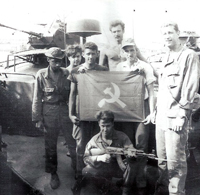 Open your mind and heart and absorb everything that is being presented to you. If you are in a military school ask a million questions. Make sure what you are studying is absolutely crystal clear. Open your mind and heart and absorb everything that is being presented to you. If you are in a military school ask a million questions. Make sure what you are studying is absolutely crystal clear.
Push yourself to be the absolute best you can be and then push further. You are not going to like everyone, but you are going to have to work with them. Liking someone and being part of a team are two totally different things. One, liking, is personal while the other, being part of a team, is professional. Never allow personal and professional get mixed into each other.
Strive to always be the best. Achieve rank and, when you do, make sure you always lead from the front.
IN WHAT WAYS HAS TOGETHERWESERVED.COM HELPED YOU REMEMBER YOUR MILITARY SERVICE AND THE FRIENDS YOU SERVED WITH.
The greatest stimulus of memory is questions. These 15 questions are laid out in such a way they walk you through your military memories from the beginning to the end.
Thank you!
Rick
|
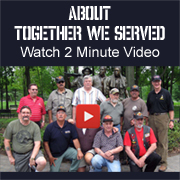

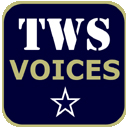
Read Other Interviews in the TWS Voices Archive
|
|
Share this Voices Edition on:


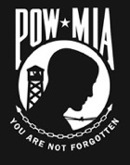  |
|
TWS VOICES
TWS Voices are the personal stories of men and women who served in the US Military and convey how serving their Country has made a positive impact on their lives. If you would like to participate in a future edition of Voices, or know someone who might be interested, please contact TWS Voices HERE.
This edition of Navy Voices was supported by:
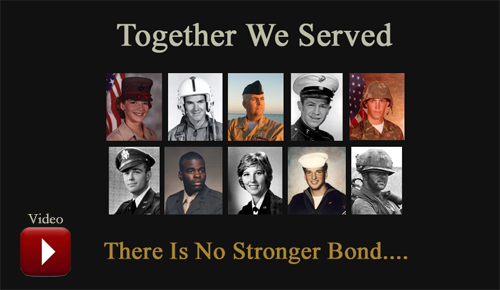
Navy.Togetherweserved.com
For current and former serving Members of the United States Navy, TogetherWeServed is a unique, feature-rich resource enabling Naval personnel to re-connect with lost Shipmates, share memories and tell their Navy story.
To join Navy.Togetherweserved.com, please click HERE.
| |